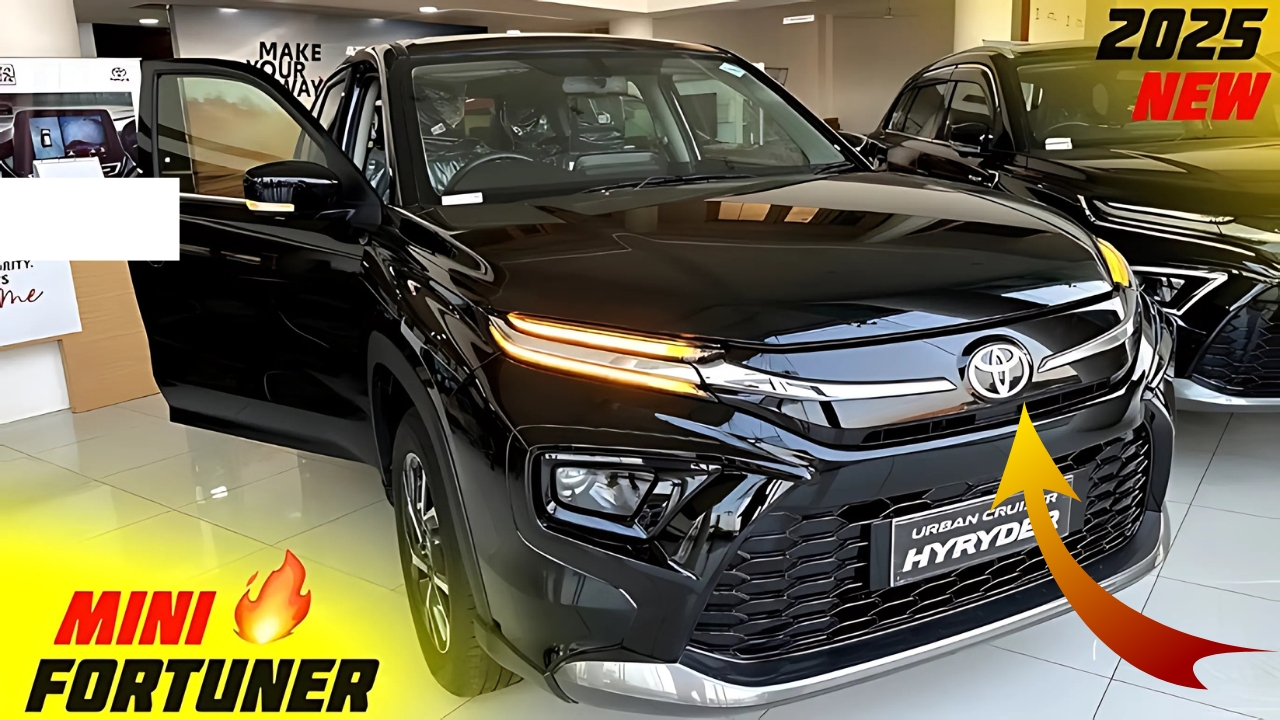Toyota Hyryder : When Toyota unveiled the Urban Cruiser Hyryder in mid-2022, keen observers immediately noticed something striking—the compact SUV carried unmistakable design elements from its considerably more expensive sibling, the Fortuner.
This deliberate styling approach has created an intriguing value proposition in India’s fiercely competitive SUV market: Fortuner-inspired aesthetics at roughly one-third the price.
Toyota Hyryder Prestigious Design Language Democratized
The Hyryder’s front fascia represents the most evident connection to Toyota’s flagship SUV.
The prominent chrome-accented grille features similar horizontal slats arranged in the distinctive Toyota pattern that has become synonymous with the brand’s premium offerings.
The sharp, angular headlamp clusters with their distinctive LED daytime running light signatures mirror the aggressive styling language that has helped establish the Fortuner’s commanding road presence.
“I initially mistook a Hyryder for a new compact Fortuner variant when I first glimpsed one at dusk,” admits Vikram Desai, who owns a 2019 Fortuner.
“It wasn’t until it drove closer that I realized it was an entirely different vehicle. Toyota has done remarkably well translating their premium design elements to a smaller package.”
This visual kinship continues along the Hyryder’s profile, where pronounced wheel arches and a gently rising beltline echo the larger SUV’s silhouette in miniaturized form.
The characteristic roof rails, while functional, further strengthen the familial resemblance.
Even the alloy wheel design on higher-end Hyryder variants bears a striking similarity to certain Fortuner editions, featuring multi-spoke arrangements with machined surfaces that convey sophistication typically absent in the sub-₹20 lakh segment.
Toyota Hyryder Premium Interior Touches Within Reach
The design similarities extend beyond exterior aesthetics. Inside the cabin, Toyota has incorporated several elements reminiscent of the Fortuner, albeit with materials reflecting the significant price difference.
The layered dashboard design with its horizontally oriented elements shares clear DNA with more expensive Toyota SUVs.
The steering wheel, though slightly smaller, features similar control arrangements and contours.
Sanjay Krishnan, who recently purchased a Hyryder after test-driving several competitors, notes: “Having sat in my colleague’s Fortuner several times, I immediately recognized certain interior elements—the door handle design, the way the center console flows, even small details like the window switch panels.
They’ve obviously been produced to different cost targets, but the design philosophy feels connected.”
Higher trim levels of the Hyryder incorporate ventilated front seats, a panoramic sunroof, and a 360-degree camera system—features that, until recently, remained exclusive to vehicles at substantially higher price points.
This democratization of premium features further strengthens the value proposition for buyers seeking Fortuner-like amenities without the corresponding investment.
Toyota Hyryder Sensible Engineering Beneath Familiar Styling
Beneath its Fortuner-inspired exterior, the Hyryder makes engineering choices appropriate to its price positioning and intended usage patterns.
Rather than attempting to mimic the Fortuner’s ladder-frame construction and off-road hardware, Toyota has sensibly opted for a monocoque architecture shared with Maruti Suzuki (developed under the Toyota-Suzuki partnership).
This platform-sharing approach enables the attractive pricing (starting around ₹10.5 lakh, ex-showroom) while still delivering comfortable on-road dynamics suited to the vehicle’s primarily urban mission.
The available mild hybrid and strong hybrid powertrains—technologies not yet offered in the Fortuner—actually give the Hyryder certain technological advantages over its more expensive inspiration.
Dr. Anand Kulkarni, automotive technology consultant, explains: “Toyota has been quite strategic here.
They’ve borrowed the aspirational design elements from the Fortuner while implementing more modern, efficiency-focused powertrains.
The hybrid system in particular represents more advanced technology than what’s currently available in the Fortuner, despite the significant price difference.”
Toyota Hyryder Market Positioning That Leverages Legacy
Toyota’s strategy with the Hyryder demonstrates sophisticated brand management—leveraging the established visual equity of their flagship SUV to enhance the appeal of their entry in the highly competitive compact SUV segment.
This approach particularly resonates with value-conscious Indian consumers who appreciate recognizable premium design cues.
“We were initially considering the Hyundai Creta and Kia Seltos,” shares Priya Mehta, who purchased a hybrid variant of the Hyryder in December 2022.
“The Toyota’s resemblance to the Fortuner definitely influenced our decision—it carries a certain road presence that most compact SUVs lack.
Several relatives have mistaken it for a much more expensive vehicle, which I’ll admit is rather satisfying.”
For buyers who have long admired the Fortuner’s commanding aesthetics but found its ₹35-50 lakh price range prohibitive, the Hyryder offers a compelling compromise.
It delivers approximately 70% of the visual impact at 30% of the cost—a value equation that explains the growing presence of these vehicles on Indian roads despite fierce competition from established players like Hyundai, Kia, and Maruti Suzuki.
As Indian consumers increasingly seek vehicles that maximize perceived value while minimizing actual expenditure, the Hyryder’s Fortuner-inspired design may prove Toyota’s most astute market strategy in years.
Also Read This-
1990’s time Yamaha RX 100 relaunching soon in 2025
These 5 Rare Bicentennial Quarters Coins Value is $10 Million each
Toyota Innova 2025 model launch soon with attractive look
